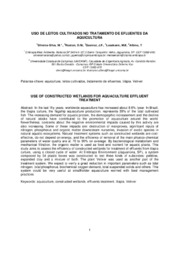Uso de leitos cultivados no tratamento de efluentes da aquicultura.
Uso de leitos cultivados no tratamento de efluentes da aquicultura.
Autoria: SILVEIRA-SILVA, M.; ROSTON, D. M.; QUEIROZ, J. F. de; LOSEKANN, M. E.; ALBINO, T.
Resumo: In the last fifty years, worldwide aquaculture has increased about 8.8% /year. In Brazil, the tilapia culture, the flagship aquaculture production, represents 39% of the total cultivated fish. The increasing demand for aquatic protein, the demographic increasement and the decline of natural stocks have contributed to the promotion of aquaculture around the world. Nevertheless, concerns about the negative environmental impacts caused by this activity are also increasing. Some of these impacts are: destruction of mangroves, significant inputs of nitrogen, phosphorus and organic matter downstream nurseries, invasion of exotic species in natural aquatic ecosystems. Natural treatment systems such as constructed wetlands are costeffective, do not depend on energy, and the efficiency of removal of the main physico-chemical parameters of water quality are at 70 to 90% on average. By bacteriological metabolism and mechanical filtration, the organic matter is used as food and nutrient for aquatic plants. This study aims to assess the efficiency of constructed wetlands for treatment of effluents from tilapia culture, using a closed cycle of water. At Embrapa Environment (Jaguariúna, SP), a system composed by 54 plastic boxes was constructed to test three kinds of substrates: pebbles, expanded clay and a mixture of both. The plant Vetiver was used as another part of the treatment system. We expect to verify a great reduction in important parameters such as total nitrogen, total phosphorus, biochemical oxygen demand, total suspended solids and others. This system could be very useful at smallholder aquaculture worried with best management practices.
Ano de publicação: 2011
Tipo de publicação: Artigo em anais e proceedings
Unidade: Embrapa Meio Ambiente
Palavras-chave: Aquaculture, Aquicultura, Constructed wetlands, Effluents, Leitos cultivados, Tilapia, Tratamento de efluentes, Vetiver
Observações
1 - Por padrão são exibidas publicações dos últimos 20 anos. Para encontrar publicações mais antigas, configure o filtro ano de publicação, colocando o ano a partir do qual você deseja encontrar publicações. O filtro está na coluna da esquerda na busca acima.
2 - Para ler algumas publicações da Embrapa (apenas as que estão em formato ePub), é necessário ter, no celular ou computador, um desses softwares gratuitos. Sistemas Android: Google Play Livros; IOS: iBooks; Windows e Linux: software Calibre.
Acesse outras publicações
Acesse a Base de Dados da Pesquisa Agropecuária (BDPA) para consultar o acervo completo das bibliotecas da Embrapa.

